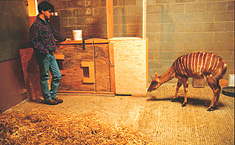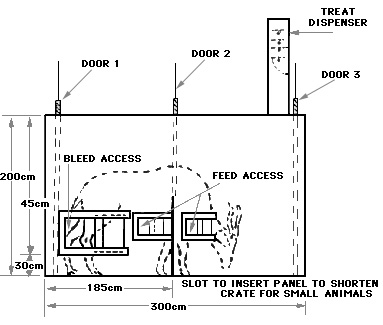

Habituation and positive reinforcement procedures were successfully used for low stress blood sampling of nyala (Tragelaphus angasi) at the Denver Zoological Gardens.
Four adult females and three offspring were conditioned with a food reward, to voluntarily enter a plywood crate for bimonthly blood sampling from the rear leg. Habituated and conditioned, non-sedated nyala could also be given intramuscular injections and be palpated on the udder and abdomen.



Successful blood sampling of an antelope.
Conditioning and habituation were done slowly and carefully over a period of 3 months to avoid frightening the animals or causing a dangerous escape attempt.All animals remained calm during both conditioning and blood sampling procedures.
Investing the time and effort to train the nyala to crate handling resulted in improved animal welfare and blood samples that were not confounded by stress.


 The
nyala were trained for a vitamin E supplementation
study.
The
nyala were trained for a vitamin E supplementation
study.In captivity, nyala often suffer from myopathy due to vitamin E deficiency.This made it possible to accurately measure vitamin E levels, which will aid nutritionists in determining supplementation levels.
- Vitamin E levels will change when the animal is stressed.
- Training the animals to cooperate during blood sampling eliminated handling stress.
 Click here to return to the Homepage for more information on animal behavior, welfare, and care.
Click here to return to the Homepage for more information on animal behavior, welfare, and care.